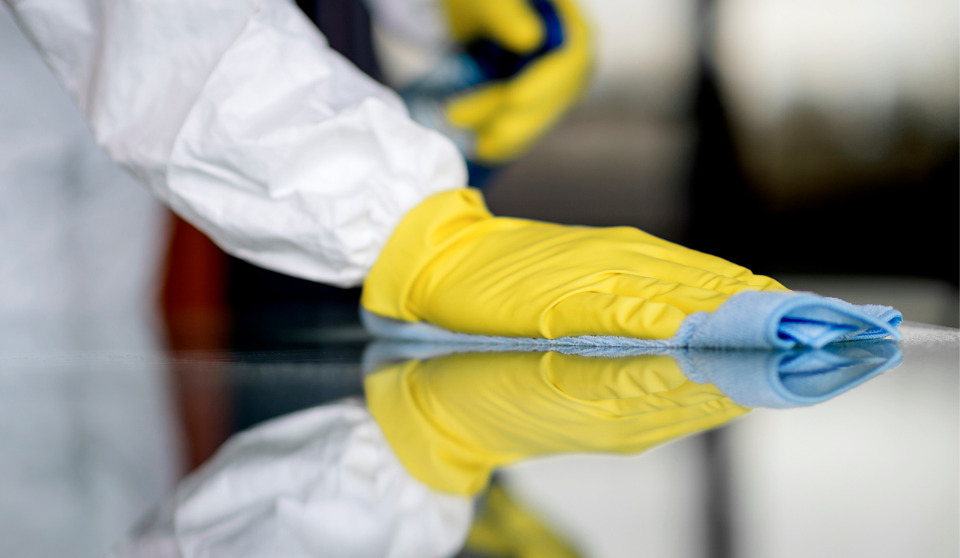Hand protection is a key piece of PPE, especially during the COVID-19 pandemic…

Gloves have been around for hundreds, if not thousands, of years.
A recent article from National Geographic reports that utilitarian gloves have been around since Ancient Greece. Indeed, Homer mentions characters wearing gloves to protect from brambles in his epic The Odyssey. National Geographic states that gloves became more common in Medieval times and were certainly worn by workers, with knights and warriors wearing metal gauntlets or chain-mail for battle or blacksmiths wearing leather gloves for smithing.
Gloves have been a constant throughout history, from factory workers in the Industrial Revolution to doctors and surgeons in the late 19th century.
And that’s probably for the best because, in the workplace, hands are among the body parts most at risk of injury. Indeed, workers’ hands face a number of hazards: cuts, abrasions, heat injuries, chemical burns, carpal tunnel syndrome, etc.
According to 2019 statistics from the Workplace Safety and Insurance Board (WSIB), the most common workplace injury in Ontario is to multiple body parts. (From 2007 to 2016, the most commonly injured part of the body was the lower back.)
In 2019, injuries to body parts made up 15 per cent of allowed lost-time claims (followed by the lower back at 13 per cent).
This same report indicates that sprains and strains are the most common injury for all parts of the body.
Looking at earlier reports from Statistics Canada, in 2003, the hand was the body part most frequently injured on the job, with more than one quarter (28 per cent) of work injuries being to the hand. This was followed by lower back injuries (16 per cent).
According to the 2003 data, the most frequent type of occupational injury to the hand is sprain or strain, followed by cuts and then fractures.
Looking at more recent data from Statistics Canada, the most common types of injuries sustained at work are sprains and strains (49.9 per cent), followed by cuts, punctures or bites (19.2 per cent) and broken or fractured bones (8.7 per cent).
The 2018 data from the National Work Injury/Disease Statistics Program (NWISP), shared by the Association of Workers’ Compensation Boards of Canada (AWCBC), shows that the trunk (which would include the lower back) accounts for 91,415 lost time claims in Canada, followed by the upper extremities (which would include the hands), which account for 54,075 lost time claims in Canada.
While the data may be slightly confusing, it is evident that hands are among the most injured body parts in Canada.
As we can see, most occupations are affected by hand-related hazards and, as such, it is important for employers and workers to understand what hand protection is and how to correctly use it.
What is hand protection and what is it for?
We shall mainly be focusing on gloves, but hand protection can also include PPE such as finger guards, barrier creams, etc. It can also be used with arm protection such as sleeves or coverings.
A recent U.S. Department of Labor study found that injuries to fingers and hands made up 23 per cent of workplace injuries. The Department of Labor study says that hand injuries rank the highest in preventable injuries.
The study found that the majority of employees who suffered hand injuries were not wearing gloves at the time or were wearing the wrong type of glove. Backing this up, a recent Occupational Safety and Health Administration (OSHA) study found that 70.9 per cent of hand and arm injuries could have been prevented by using appropriate PPE — notably, safety gloves.
According to Princeton University’s Office of Environmental Safety, different types of gloves protect against different types of hazards. It identifies four main types of gloves currently available:
- Gloves that protect against wounds such as cuts, burns or punctures. For these types of injuries, leather or canvas gloves were initially touted as a solution. Now, industry insiders say that cut-resistant gloves made of engineered yarns are the way to go.
- Gloves that protect against dirt or rubbing wounds such as chafing and abrasions. Fabric and coated fabric gloves are a solution for this.
- Gloves that protect against electrical hazards. For this, insulated rubber gloves are an optimal choice.
- Gloves that protect against chemical hazards. For this, ideally, chemical- and liquid-resistant gloves would be the safest solution.
Employment and Social Development Canada points to additional hazards for which gloves would be needed, such as heat and cold (aluminized fabrics of nylon, rayon, wool or glass gloves), ionizing radiations (lead-lined gloves) or welding and rough surfaces (thick leather gloves).
If you want to know the best work gloves for winter, find out what features to look at when choosing work gloves for your staff here.
For every single kind of environment, there is a type of glove, says Kwan Lo, managing director at Taste International, which owns the Aquila glove brand.
Princeton’s Office of Environmental Health and Safety also raises the issue that potential hazards are not the only thing to consider when choosing gloves. Indeed, fit and comfort are also important. Glove length or size is important, as is thickness as well as concerns around dexterity.
On that last point, the Canadian Centre for Occupational Health and Safety (CCOHS) offers more details.
For optimal protection, gloves need to be cared for and maintained, as per manufacturers’ instructions. They need to fit properly and cover the skin, making sure there is no space between glove and sleeve. Users should not wear torn or damaged gloves.
Environmental Health and Safety (EHS) at Ryerson points out that care for PPE and safety gloves is also an essential part of hand protection.
When is hand protection required and who needs it?
Occupational health and safety legislation can vary from province to province. Broadly, the right kind of glove must be worn for the type of work being performed. The Canada Occupational Health and Safety Regulations require that workers in Canada wear PPE when performing hazardous work.
More specific details will vary depending on whether a profession is federally regulated or not.
The Canada Labour Code, which mostly only applies to federally regulated industries, says the employer is responsible for providing prescribed safety materials, equipment, devices and clothing to every person in the workplace. Employees must use this equipment.
General PPE provisions are similar across most, if not all, provinces and territories. In Ontario for example, the Occupational Health and Safety Act says the employer must provide the PPE and maintain it in good condition.
In B.C., the Workers’ Compensation Act states that a worker is responsible for providing their own general-purpose work gloves but that an employer is responsible for providing — at no cost to the worker — all other items of PPE required by the act. Furthermore, if the PPE causes allergenic or other adverse health effects, the employer must then provide alternate equipment or safety measures.
More specifically, with regards to limb protection, the act states: “The employer must provide appropriate skin, hand, foot or body protection if a worker is exposed to a substance or condition which is likely to puncture, abrade or otherwise adversely affect the skin, or be absorbed through it.” And, “If there is a danger of injury, contamination or infection to a worker's hands, arms, legs, or torso, the worker must wear properly fitting protective equipment appropriate to the work being done and the hazards involved.”
On the manufacturer’s side, Lo says, “There are lots of standards to make sure the product is right. Within those standards, you have to make sure that all of your products are tested and respect those stringent guidelines.”
He says there are a lot of standards to make sure that the product is actually right. These standards can differ from Canada, the U.S., Europe, etc. In Europe, for example, the PPE EC directives are very stringent.
“Every single product that comes out of our factory has to be tested by a recognized or accredited laboratory. They have to conduct a test and then do a report and then issue a certificate, without which we can’t sell,” says Lo. “We’ve come a long way as a health protection industry.”
“Nowadays, everyone's wearing a pair of gloves. So that's really what helps to keep the lifespan of the hands a little bit longer. You have this barrier to protect you from hazards, environment — whether it’s work or leisure,” says Lo.
In addition to protecting the worker, there are other considerations to take into account.
“It's not just protecting the wearer, it’s also about protecting the product,” says Lo. He raises the example of people who work with glass and how gloves are important because one would not want to get fingerprints on it.
How has COVID-19 impacted hand protection?
COVID-19 has broadly impacted PPE in a number of ways. With regards to hand protection, one key piece of PPE has been dragged into the spotlight: disposable medical gloves. Disposable gloves are being used in a multitude of occupations in Canada, including (but not limited to) health care, education, hospitality and retail.
“What [manufacturers] are jumping onto now because of COVID is disposable gloves. Now when you walk in the street or go to [the] supermarket, you see people wearing disposable gloves. And, of course, there's a shortage of PPE, particularly gloves,” says Lo.
Lo says that, because of this high demand and low supply, there have been a lot of scams in recent months. Cost has also become a big concern for manufacturers and buyers alike. This issue isn’t just facing the glove sector in the current COVID climate but other key markets such as respiratory protection. Sources say that this will have a dramatic impact on glove availability and pricing well into 2021.
Broadly, there has and continues to be a huge demand for gloves. Availability is a huge concern for manufacturers. Furthermore, in ramping up production, the cost of raw materials is being driven up. This will make it difficult for factories. There are also obviously concerns over worker safety in manufacturing plants due to infection cases and, by extension, labour shortages.
Although these gloves are necessary to fight the pandemic, Lo says one negative side effect is that a higher volume of disposable gloves being made out of nitrile also means that there will be a huge impact on the environment.
“I think that, because of the pandemic, ecological and environmental concerns aren't really at the forefront anymore,” says Lo. “I think people don’t realize or forget that this is a large, unprecedented amount of waste that is being created. And some of it is actually toxic waste. And that needs to be dealt with in a specific manner. And, so, there's this massive concern.”
This is why manufacturers are now looking into cleaning and disinfecting solutions that could be used to sterilize nitrile gloves for re-use or are looking at making re-usable gloves. Hand sanitizer and soap and water work for non-sterile conditions.
“I think there's this whole separate market now being created about making reusable [gloves] or at least cleaning agents that would be used to clean [gloves],” he says. These concerns are shared by others in the industry.
How COVID-19 develops in 2021 remains to be seen, but the disposable glove market is certainly poised to dominate the safety glove conversation in the upcoming months. As stated when we first started our journey into hand protection, gloves have been a key piece of protection for workers for hundreds of years. With COVID likely to loom over worker safety for months, if not years to come, gloves won’t be going anywhere any time soon.
If you're looking for the best cut-resistant gloves to protect your staff, read this guide.
This article originally appeared in the Jan/Feb 2020 issue of COS.





